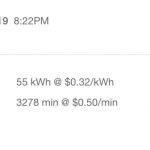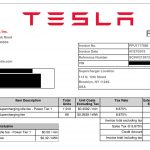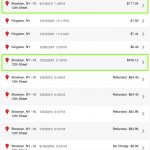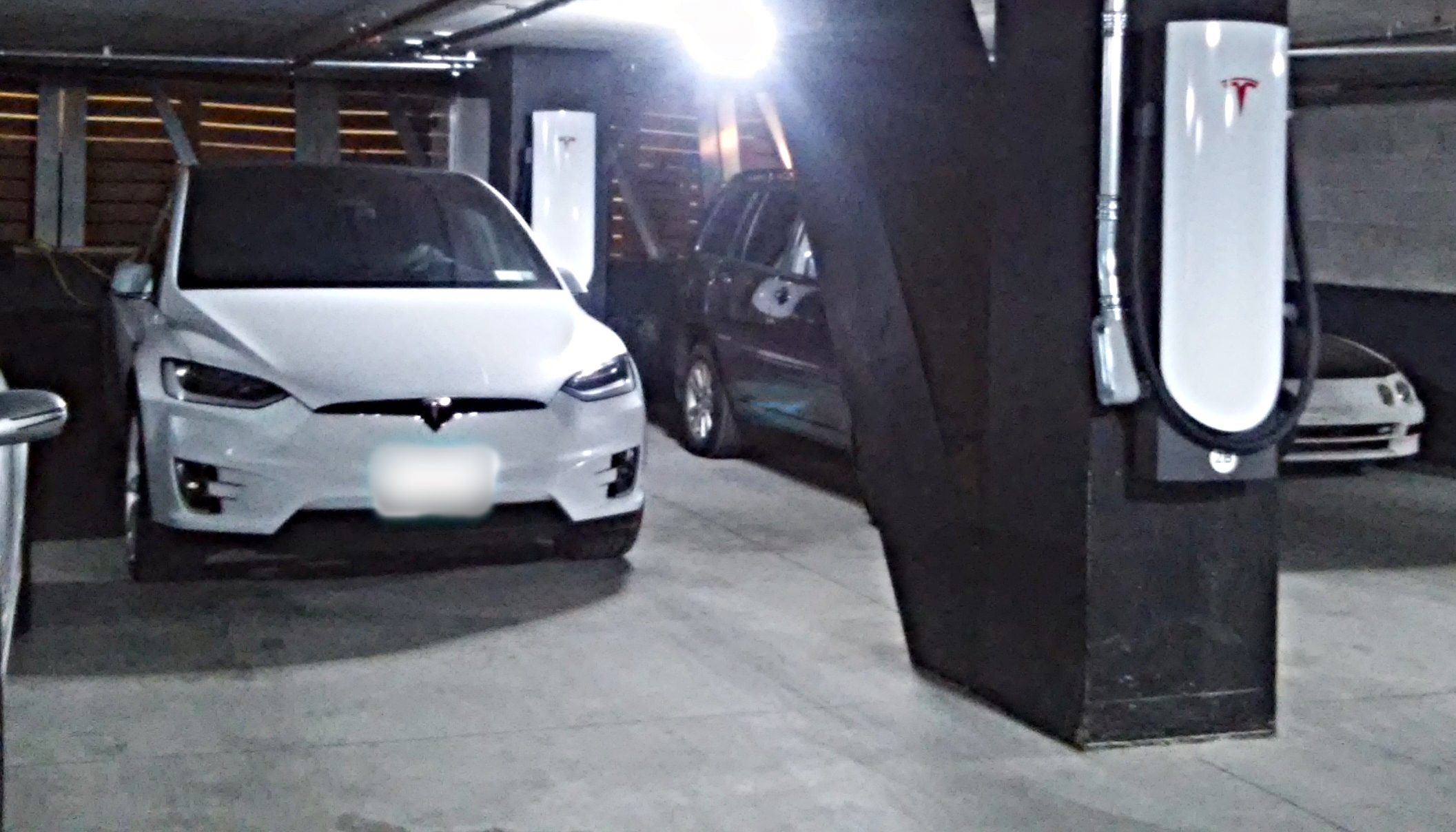
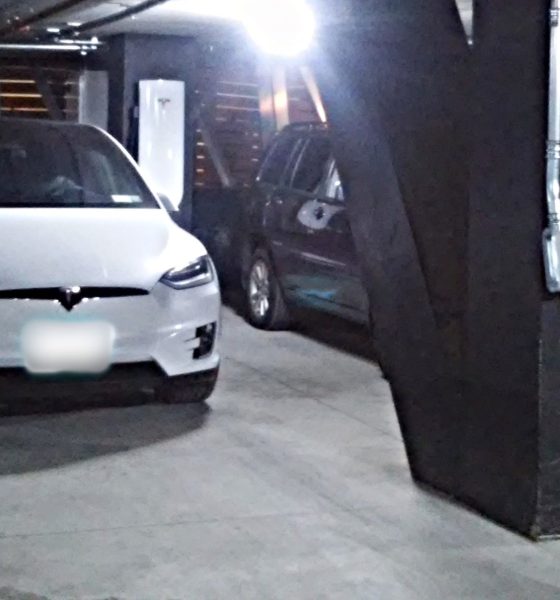
News
Tesla owner racks up $1147 in Supercharger idle fees at valet-only parking garage
For Tesla owner James Salantiri, his Model 3 and the valet-only Supercharger station at the William Vale Parking Garage in Brooklyn, NY are intertwined. With his apartment just 10 minutes away by foot from the parking garage, Salantiri is a regular in the business. He would drive over to William Vale, hand his vehicle over to the valets, and drive away the next day, charged and ready for the road.
It was a system that has worked since he took delivery of his black Long Range Model 3 RWD on March 2018. Salantiri had waited long for his Model 3, having been one of the reservation holders who waited in line to put a deposit on the vehicle during the day of its unveiling. The parking garage has served him well, even when Tesla started rolling out strict Supercharger idle fees.
Tesla initially introduced a $0.40 per minute idle fee for its Supercharger Network on December 2016 to discourage owners from keeping their vehicles connected to the high-powered charging stations even when their electric cars are fully charged. Tesla raised its idle fees on September 2018, adjusting the fees to $.50 per minute. When a charging location is fully occupied, the company’s idle fees go as high as $1.00 per minute.
This system is particularly tricky for Tesla owners like James Salantiri, who regularly use valet-only Urban Superchargers to charge their vehicles. In a message to Teslarati, the Model 3 owner noted that William Vale’s valets would usually charge Teslas and unplug them as needed when the parking garage gets full as part of their service. At times when the parking garage is relatively empty, the valets would at times go the extra mile by plugging a vehicle overnight.
When the electric car maker rolled out its updated Supercharger idle fees, Salantiri was informed by a Tesla representative that since the garage is valet-only, and since owners have no control when their vehicles are plugged in or taken off the Urban Superchargers at the location, any idle fees incurred at the parking garage would be waived. This setup worked well. Even when the vehicle is left plugged in overnight and large idle fees are incurred by his Model 3, Salantiri would see the charges either waived or refunded.
- (Credit: James Salantiri)
- (Credit: James Salantiri)
Previous idle fees at the Urban Supercharger were previously waived or refunded automatically. (Credit: James Salantiri)
Things changed recently. Upon looking at his recent bank statement, the Model 3 owner noticed two Tesla Supercharger charges to his account amounting to $1,147.16, comprised of a $171.04 charge on August 1 and a $976.12 charge on July 23. This prompted Salantiri to contact the electric car maker, where a representative reportedly informed him that a refund wasn’t possible due to the Supercharger not being on Tesla property. In the following call that was escalated to a supervisor, Salantiri was told that the recent fees could not be waived or refunded since the company’s waive/refund policy for Supercharger idle fees only covers an initial charge. Attempts to contact the parking garage’s new management about the issue were also unsuccessful.
A look into Tesla forums such as the Tesla Motors Club shows that Salantiri’s issue was not an isolated incident. Another Tesla owner, who goes by the username choatie88, noted that he was also charged a notable idle fee at the same location since his vehicle was left to charge overnight. In a message, the Tesla owner noted that he eventually got a one-off refund once he explained the parking garage’s valet-only nature to Tesla. Unfortunately for Salantiri, his one-off refund/waive credit appears to have been used up over his regular trips to the location.
- (Credit: James Salantiri)
- (Credit: James Salantiri)
The Model 3 owner’s recent Urban Supercharger idle fees from the valet-only parking garage. (Credit: James Salantiri)
Tesla noted in its Supercharger idle fee announcement last September that there is no upper limit on the amount of fees that a vehicle could accrue. This is absolutely fair in public charging stations where owners have full control when they could plug in and remove their vehicles from a Supercharger, but this system hits somewhat of a gray area when it comes to valet-only parking locations. It would be difficult for owners to remove their vehicles from a Supercharger, after all, if they do not have access to their cars.
In a message to Teslarati, Salantiri noted that it would perhaps be best for Tesla to roll out an upper limit for Supercharger idle fees, at least in locations that are valet-only. Or perhaps the electric car maker could just maintain its previous system, which automatically addresses idle fees in places where owners could not disconnect their vehicles from Superchargers. In places like the William Vale Parking Garage, which city dwellers depend on for their charging needs, perhaps Tesla could also roll out Destination Chargers instead, which are not as quick as Urban Superchargers, but do not accrue idle fees once a vehicle is fully charged.
Update:
The Model 3 owner has informed us that his vehicle’s idle fees at the William Vale Parking Garage have been waived by Tesla. A representative from the parking garage further explained that an error on Tesla’s backend caused the charge to be levied, but it has been reversed, considering that idle fees do not apply to valet-only Superchargers.

News
Tesla FSD fleet is nearing 7 billion total miles, including 2.5 billion city miles
As can be seen on Tesla’s official FSD webpage, vehicles equipped with the system have now navigated over 6.99 billion miles.

Tesla’s Full Self-Driving (Supervised) fleet is closing in on almost 7 billion total miles driven, as per data posted by the company on its official FSD webpage.
These figures hint at the massive scale of data fueling Tesla’s rapid FSD improvements, which have been quite notable as of late.
FSD mileage milestones
As can be seen on Tesla’s official FSD webpage, vehicles equipped with the system have now navigated over 6.99 billion miles. Tesla owner and avid FSD tester Whole Mars Catalog also shared a screenshot indicating that from the nearly 7 billion miles traveled by the FSD fleet, more than 2.5 billion miles were driven inside cities.
City miles are particularly valuable for complex urban scenarios like unprotected turns, pedestrian interactions, and traffic lights. This is also the difference-maker for FSD, as only complex solutions, such as Waymo’s self-driving taxis, operate similarly on inner-city streets. And even then, incidents such as the San Francisco blackouts have proven challenging for sensor-rich vehicles like Waymos.
Tesla’s data edge
Tesla has a number of advantages in the autonomous vehicle sector, one of which is the size of its fleet and the number of vehicles training FSD on real-world roads. Tesla’s nearly 7 billion FSD miles then allow the company to roll out updates that make its vehicles behave like they are being driven by experienced drivers, even if they are operating on their own.
So notable are Tesla’s improvements to FSD that NVIDIA Director of Robotics Jim Fan, after experiencing FSD v14, noted that the system is the first AI that passes what he described as a “Physical Turing Test.”
“Despite knowing exactly how robot learning works, I still find it magical watching the steering wheel turn by itself. First it feels surreal, next it becomes routine. Then, like the smartphone, taking it away actively hurts. This is how humanity gets rewired and glued to god-like technologies,” Fan wrote in a post on X.
News
Tesla starts showing how FSD will change lives in Europe
Local officials tested the system on narrow country roads and were impressed by FSD’s smooth, human-like driving, with some calling the service a game-changer for everyday life in areas that are far from urban centers.

Tesla has launched Europe’s first public shuttle service using Full Self-Driving (Supervised) in the rural Eifelkreis Bitburg-Prüm region of Germany, demonstrating how the technology can restore independence and mobility for people who struggle with limited transport options.
Local officials tested the system on narrow country roads and were impressed by FSD’s smooth, human-like driving, with some calling the service a game-changer for everyday life in areas that are far from urban centers.
Officials see real impact on rural residents
Arzfeld Mayor Johannes Kuhl and District Administrator Andreas Kruppert personally tested the Tesla shuttle service. This allowed them to see just how well FSD navigated winding lanes and rural roads confidently. Kruppert said, “Autonomous driving sounds like science fiction to many, but we simply see here that it works totally well in rural regions too.” Kuhl, for his part, also noted that FSD “feels like a very experienced driver.”
The pilot complements the area’s “Citizen Bus” program, which provides on-demand rides for elderly residents who can no longer drive themselves. Tesla Europe shared a video of a demonstration of the service, highlighting how FSD gives people their freedom back, even in places where public transport is not as prevalent.
What the Ministry for Economic Affairs and Transport says
Rhineland-Palatinate’s Minister Daniela Schmitt supported the project, praising the collaboration that made this “first of its kind in Europe” possible. As per the ministry, the rural rollout for the service shows FSD’s potential beyond major cities, and it delivers tangible benefits like grocery runs, doctor visits, and social connections for isolated residents.
“Reliable and flexible mobility is especially vital in rural areas. With the launch of a shuttle service using self-driving vehicles (FSD supervised) by Tesla in the Eifelkreis Bitburg-Prüm, an innovative pilot project is now getting underway that complements local community bus services. It is the first project of its kind in Europe.
“The result is a real gain for rural mobility: greater accessibility, more flexibility and tangible benefits for everyday life. A strong signal for innovation, cooperation and future-oriented mobility beyond urban centers,” the ministry wrote in a LinkedIn post.
News
Tesla China quietly posts Robotaxi-related job listing
Tesla China is currently seeking a Low Voltage Electrical Engineer to work on circuit board design for the company’s autonomous vehicles.

Tesla has posted a new job listing in Shanghai explicitly tied to its Robotaxi program, fueling speculation that the company is preparing to launch its dedicated autonomous ride-hailing service in China.
As noted in the listing, Tesla China is currently seeking a Low Voltage Electrical Engineer to work on circuit board design for the company’s autonomous vehicles.
Robotaxi-specific role
The listing, which was shared on social media platform X by industry watcher @tslaming, suggested that Tesla China is looking to fill the role urgently. The job listing itself specifically mentions that the person hired for the role will be working on the Low Voltage Hardware team, which would design the circuit boards that would serve as the nervous system of the Robotaxi.
Key tasks for the role, as indicated in the job listing, include collaboration with PCB layout, firmware, mechanical, program management, and validation teams, among other responsibilities. The role is based in Shanghai.
China Robotaxi launch
China represents a massive potential market for robotaxis, with its dense urban centers and supportive policies in select cities. Tesla has limited permission to roll out FSD in the country, though despite this, its vehicles have been hailed as among the best in the market when it comes to autonomous features. So far, at least, it appears that China supports Tesla’s FSD and Robotaxi rollout.
This was hinted at in November, when Tesla brought the Cybercab to the 8th China International Import Expo (CIIE) in Shanghai, marking the first time that the autonomous two-seater was brought to the Asia-Pacific region. The vehicle, despite not having a release date in China, received a significant amount of interest among the event’s attendees.

